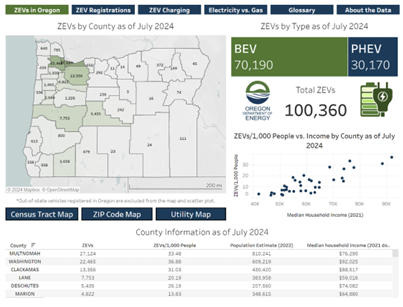Transportation Fuels: What We Use
The transportation sector covers the movement of goods, services, and people—including passenger and commercial vehicles, trains, aircraft, boats, barges, and ships. Fuel, mostly in the form of petroleum products, is used directly for vehicles and to fuel equipment.
Transportation was the largest share of energy use among the sectors in 2022. In fact, the Oregon’s transportation sector used 36.7% — or 318.4 trillion Btu — of all the energy consumed in the state. Petroleum-based products accounted for 91% of fuel consumed in this sector. Alternative fuels or biofuels like ethanol, biodiesel, and renewable diesel accounted for 8.6%, and electricity and natural gas accounted for 0.3% of the fuels consumed.
Fast Facts
36.7%: Transportation sector’s share of Oregon’s energy use in 2022.
493: Gallons Annual amount of fuel used by a 2005 typical model vehicle. It also emits about 6.08 metric tons of CO2 equivalent per year.
402: Gallons Annual mount of fuel used by a 2022 typical model vehicle. It also emits about 4.69 metric tons of CO2 equivalent per year.
In 2022, nearly 1.36 billion gallons of gasoline powered vehicles on Oregon roads.
That’s over 318 gallons per Oregonian.
The typical Oregon household has at least two cars.
For electric vehicle drivers, no matter where a car is fueled in Oregon, drivers reduce their greenhouse gas emissions by 50% to 95% by fueling with electricity.
Transportation Emissions Over Time
Metric Tons of CO2e produced by all Light-Duty Vehicles and Metric Tons of CO2e per Vehicle
Transportation is the state’s largest source of sector-based GHG emissions. Transportation emissions primarily result from the direct combustion of petroleum products in on- and non-road vehicles (such as construction equipment, agricultural vehicles, and offroad recreational vehicles).
About 55% of Oregon’s transportation emissions are from gasoline combustion in passenger cars and other gaspowered vehicles, and about 33% are from medium- and heavyduty diesel vehicles.
Oregon’s EV Dashboard Learn More
Oregon’s Zero Emissions Vehicle Targets
Senate Bill 1044 and the Advanced Clean Vehicles II Rules set the following targets:
250,000 registered ZEVs on Oregon roads by 2025
At least 25% of registered vehicles and at least half of the new vehicles sold annually are ZEVs by 2030
At least 100% of new vehicles sold annually are ZEVs by 2035
Oregon’s EV Charging
24 charging networks
3,193 public EV chargers
1,259 charging locations
Data through July 2024





